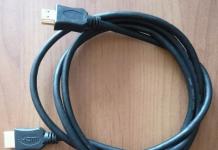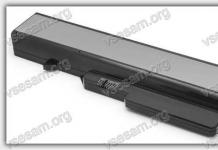Find the router's IP address. Most new routers have a sticker with an IP address. In the case of older models, this information can be found in the documentation for the router. If you can’t find the information you need anywhere, you can search the Internet for your router model.
- An IP address is four groups of 3 digits separated by a dot.
- Most standard IP addresses are 192.168.1.1, 192.168.0.1 or 192.168.2.1.
On a computer connected to the router, open a web browser. Enter the router's IP address in the address bar and press Enter. The browser will try to connect to the router's configuration menu.
- If your router came with an installation disk, you can run the configuration program instead. It performs almost the same functions.
Enter login and password. To access the router configuration page, enter the correct username and password. Most routers have a standard username and password that you must use to log in. They vary by model and should be printed on the router or in the documentation.
- The most common login is "admin".
- The most common passwords are "admin" and "password".
- For some routers, it is enough to enter only the login and leave the password blank; in some models, you also don’t have to enter the login.
- If you cannot find the standard login and password, look online for the standard login for your router model. If it has been changed, to reset to factory settings, hold down the Reset button on the back of the router for 10 seconds.
Open your wireless network settings. After logging into the router, you will be taken to the main menu or status screen. There will be several options to choose from. The Internet section can be left unchanged unless you have received special settings from your Internet service provider. In the Wireless Networks section, you can change your wireless network settings.
Enter a name for the wireless network. In the Wireless Networks section, you will see an SSID or "Name" field. Enter a unique name for your wireless network. This is what other devices will see when scanning to wireless networks.
- Check the box to enable broadcast information about the service area. This will enable the wireless network.
Select a security method. Select from the list of available security options. For maximum security, select WPA2-PSK as the encryption method. It is the most resistant to hacking and will best protect you from attacks by hackers and intruders.
Create a passphrase. Once you have chosen the encryption method, enter the passphrase. This must be a complex password consisting of a combination of letters, numbers and symbols. Don't use passwords that can be easily identified by your network name or information about you.
Save your settings. Once you have named and secured your wireless network, click the Apply or Save button. It may take some time for the settings to be applied. Once the router reboots, your wireless network will become available.
Hello! I’ll probably start with the fact that I’ve already written a lot of articles on setting up Wi-Fi routers, and about problems that may arise during the setup and operation of wireless access points. All articles are on this site, mainly in the “Internet” section. In this article I will provide links to the most necessary materials that may be useful to you when setting up a Wi-Fi router.
What is this article about? I want to talk in general terms about installing and configuring a Wi-Fi router yourself. Perhaps you want to buy a router and create a wireless network at home. Now is the time that we can’t live without it. One computer connected to the Internet via cable is a thing of the past. These are constant fights in the family for the opportunity to surf the Internet and a long line in the back :).
Moreover, now almost all devices have the ability to connect to the Internet via Wi-Fi. Phones, smartphones, tablets, laptops, netbooks, etc. And if there is no Wi-Fi at home, then you are simply limiting their capabilities.
Before I forget, I would like to separately write a few words about the harmfulness of Wi-Fi, or rather the waves that a Wi-Fi router emits. I wrote about this in a separate article. If you are interested in this question, then read the article. I will only say that there is no point in hiding from these “harmful waves”.Start searching for networks in your home. And you will see how many routers your neighbors have already installed (provided that you do not live in a village, there most likely will not be Wi-Fi networks). Moreover, the radiation from Wi-Fi is several times less than from a regular mobile phone, which we also hold near our heads. So they are afraid of a Wi-Fi router, this is not entirely normal and stupid.
Another plus of a wireless access point (aka Wi-Fi router) the fact that you can completely get rid of wires in your home. For some reason I am sure that your computer is not installed near the front door :). This means that the network cable needs to be stretched through the entire house. What if you just made a good renovation? A Wi-Fi router solves all problems. You can put it or hang it near the entrance doors, and some manage to place it in the common corridor (well, when there is a corridor for two apartments).
You probably ask: “But what about an ordinary desktop computer that does not have the ability to connect via Wi-Fi and needs to connect via a network cable?” everything is very simple, there are Wi-Fi receivers for such cases. I wrote about how to connect a desktop computer to Wi-Fi in an article.
Is it possible to connect and configure a Wi-Fi router yourself?
Maybe! And put aside any doubts and excuses, like I don’t know how, it’s difficult, etc. Well, for example, I set everything up myself, and I also wrote instructions for the site. If you are planning to call a specialist who will install and configure Wi-Fi, then my advice to you is to try it yourself first. It won't work out- Call the master. It will work out- Great! Will you be able to, for example, change the provider and what, call the technician again? And then you can set everything up yourself. Moreover, everything is relatively simple. You just need to want it!

Here is my detailed information to help you. Everything is there in detail and point by point, there shouldn’t be any problems. Using these instructions, you can configure other routers, because the process is practically no different. A lot of useful information is also in the comments, you can read them too.
Now I just remembered that I didn’t write about choosing a Wi-Fi router, because you are probably very interested in this question. I won’t recommend anything specific. Choose a router based on the amount of money you are willing to spend on it and the advice of the store salesperson (well, if the sales consultant is smart). All routers are good in their own way and all have their drawbacks. A year ago I bought a cheap one for my home (250 UAH/1000 rubles) router TP-Link TL-WR841N, the store recommended it to me. Excellent device, after a year of operation, no problems at all.
Possible problems when setting up a Wi-Fi router yourself
Judging by the comments to the articles on this site, there are problems. But this shouldn't scare you. Someone got a defective router, someone simply didn’t want to understand the nuances of the setup and immediately wrote: “Serega help, for some reason it’s not working!” :).
Setting up a router - main points:
- Connect the router to the computer via a network cable
- Connecting the Internet to the router
- Go to the router settings
- Setting up a tab WAN. Settings from the provider, if you don’t know what settings to specify, then you can safely call and ask the provider.
- Setting up a wireless Wi-Fi network. Set password, encryption type, security type, etc.
These are the main points; read the article for more details on setting up. As for various kinds of problems and errors, they most often arise when specifying settings from the provider and when setting up a wireless network.

But if there is a problem, then there is a solution. I tried to collect all the main problems when setting up a router and connecting to Wi-Fi. Of course, not just problems, but their solutions.
For convenience, I'll probably make a list of links to pages where I wrote about solving certain errors:
- Well, the most common problem when setting up a router is probably... Not only is this article the most popular on this site, so at the moment (04/09/2013) it is left for 739 comments.
- And others... :)
I tried to collect all the articles with the main errors. If you don’t find something, use the site search, maybe I missed something. Well, or ask in the comments, we’ll try to figure it out.
Wireless networks are a very convenient tool for solving everyday problems related to accessing the Internet. Today it is quite difficult to find a person who does not have a router at home. Installing a Wi-Fi router yourself is not a difficult task, and now we will look in detail at how to do it.
Device selection
Before moving on to the question of how to install a router, you should select it. Nowadays you can find a great variety of different models of Wi-Fi routers in stores. However, not all of them will suit your requirements. There are several parameters to consider in this matter:
- the presence of a powerful external antenna - the description should indicate the power, for example, 5;
- convenient and intuitive interface - this will allow you to easily and quickly understand the settings. Today, routers from the company have the simplest and most intuitive interface;
- supported standards – there are several standards that are most common:
- 802.11 is an old standard operating at 2.4 GHz;
- 802.11 – is also considered obsolete and operates at a frequency of 2.4 GHz;
- 802.11 is a new standard that operates at 5 GHz and is characterized by higher data transfer rates over wireless networks (up to 300 Mbps). It is worth noting that routers that support the 802.11 type can work with all types of devices, even with outdated models operating at a frequency of 2.4 GHz. In this matter, it is best to give preference to routers that support operation on all these standards (make sure that the box bears the designation “N” - 300 Mbits);
- the presence of the required ports for connecting an Internet cable, modems, computers, and so on. Here you should proceed from your preferences and requirements.
When choosing equipment, we advise you to avoid cheap Chinese devices. Such gadgets work with constant glitches. Now let's move on to the main question - how to install a router at home. It's probably best to start by determining where the access point will be located.
Determining the location
It is preferable to place the router in the central part of the room (or as close to the center as possible) somewhere under the ceiling or on a cabinet.
The higher the access point is, the fewer obstacles there are in the signal path and the larger the coverage area.
When deciding how to install a Wi-Fi router at home, you should avoid mirrors, as they reflect the signal and radio waves simply will not pass through; household appliances, especially those with strong radiation of electromagnetic waves, such as microwave ovens (microwave ovens), refrigerators, radios, home phones, and so on.
If the room is quite large and one router is not able to cover the entire territory, then you can significantly increase the coverage area. It is worth noting that each router has wall mounts. So, now you know where and how to install the router yourself. Now you can proceed to configuration.
Equipment setup
Typically, when you turn on the router for the first time, Wi-Fi is already working. All you have to do is change the network name and assign a password for security.
First, we need to go to the access point parameters. To do this, you need to find out the IP address of the router. It is indicated on the factory sticker that is on each router (carefully inspect the gadget from all sides).
You can also find it out on the command line. Just connect to the network, open the command line, enter the ipconfig command and press . Next, we need to find the line “Main gateway” - the address we need will be there.
Now you need to enter this IP address into the address bar of any browser and click. Typically, the IP address looks like this: 192.168.0.1 or 192.168.1.1. There may be other meanings - this has already been clarified by the methods described above.
So, installing a Wi-Fi router at home involves two setup steps:
- setting up local network and Wi-Fi;
- setting up an Internet connection.
Let's take a closer look at both points.
Setting up a local network
When asking how to install a new router, the first thing you should look at is setting up the local network and Wi-Fi connection. We will look at further steps using the example of setting up a TP-Link router. If you have a different model, then don’t worry: all routers are configured according to the standard scheme. Differences may only be in the names of some sections and in the appearance of the interface.
So, follow these steps:
This completes the local network setup. But installing a router doesn't end there. Now we need to configure Internet access.
WAN setup
In order to set up an Internet connection (WAN), you need to know what type of connection your ISP uses. There are several options:
- PPPoE – in this case you need to enter the login and password that your provider gave you;
- binding by MAC address - in this case, as a rule, there is no need to manually enter network parameters;
- static IP - this means that you are assigned a specific IP address and other parameters that must be entered manually.
In any case, you will have to call your provider and find out exactly how the router is configured (what type of connection is used).
There are options when you don’t need to configure anything at all. That is, you connect the router to the provider’s cable, connect your computer to your network and load any website. The first time you try, the system will display a window in which you will need to enter the username and password assigned by your provider. After entering the data, the router will automatically bind to the system and the network will be configured.
Not so long ago, a computer, and especially a laptop, was a luxury. Today, almost every family has a computer or laptop, and in many families almost every family member has these devices. Each such device must have access to the Internet, since a computer without the Internet is a “box”. With the development of technology, in order to divide Internet traffic into several devices, it is no longer necessary to connect a separate cable to each device; everything can be done over the air - using Wi-Fi technology.
The content of the article:
Benefits of Wi-Fi
Before we talk about setting up a Wi-Fi network at home, we’ll talk about the tasks and advantages of this technology. So, if you need to divide your existing Internet channel into several devices, then you need a router. If you want to share the Internet channel by connecting devices without using wires, then a Wi-Fi router will help you with this. We have already told you about this and therefore, before purchasing it, we recommend that you read this article again. A Wi-Fi router is a great option if you have devices that support Wi-Fi networks. Thus, by installing a Wi-Fi router at the most central point, you can provide Wi-Fi coverage throughout the entire apartment, which is very convenient, because you will not need to run unnecessary wires. If your computer does not have a Wi-Fi adapter, then this issue can be solved in two ways: install a Wi-Fi router in the room where the computer is located, or purchase a Wi-Fi adapter. A Wi-Fi adapter is a small device in the form of a flash drive or in the form of a card inserted into a PCI slot.Considering that almost every family needs to install a Wi-Fi router, we will tell you how to set it up yourself, without calling a technician.
Setting up a Wi-Fi router
To configure the router, it must be connected via a cable to a computer or laptop. The connection diagram must be shown in the instructions. We unpack the router, screw the antennas to it, then connect one part of the network cable (which comes with the kit) to the router, and the other to the computer (laptop). Then we connect the router’s power and after that we connect the Internet provider’s network cable to it.How to enter the router menu
Absolutely all Wi-Fi routers are configured using a WEB interface, this is a kind of website with settings. That is, in order to configure the router, you need to open the page with its settings in your browser. To do this, enter “192.168.1.1” in the address bar of your browser and press the “Enter” key. After this, a window will appear on the screen in which you will need to enter your login and password to access the router settings. Standard (by default) login and password from the router settings menu: “admin” - in small letters. After entering, click “OK” and get to the menu.

Reflashing a Wi-Fi router
So, in order to set up a Wi-Fi router, you first need to reflash it. If you are a fairly experienced person and know what and how, then now we will tell you what you need to do for this. If you don’t particularly like to understand all the intricacies of computer technology, then you can do without flashing the router. Firmware is a kind of operating system of the router on which its operation is based.
Why is flashing needed? Reflashing the router is necessary to ensure normal and high-quality operation of the device. As a rule, every Wi-Fi router has the same firmware version from the moment it is released until it is discontinued. This firmware only passes internal tests, but when the device goes on mass sale, users find all sorts of problems in the operation of the device in various situations. Therefore, the “native” firmware is not perfect and you may have problems with the device: low speed, freezes, problems with Wi-Fi, etc. That is why it is better to install a new firmware version.
In order to reflash the Wi-Fi router, you need to download the firmware file. Of course, you can download it from the manufacturer’s official website. To do this, on the website of the device manufacturer, find the model of your Wi-Fi router, and click on the “Downloads” tab; this is where the list of available firmware should be located. Some manufacturers may send you to an FTP server where the firmware is stored. But do not rush to download the latest version of the firmware, first read the forums where users who installed this firmware wrote a review about its work and made a conclusion: is it worth installing or not.
After downloading the archive with the firmware, unzip it and copy the firmware file to the downloads folder. In the router menu, go to the Firmware section and in the available field, indicate to the router the path to the new firmware. You can find more detailed instructions on how to reflash the router in the instructions for the device.
After flashing, go to the Network / IPConfig / Network menu (depending on the model of your router) and first enter the provider settings.

WAN connection type
- Dynamic IP / DHCP / Dynamic IP – select if the provider provides dynamic IP;
- Static ip / Statistical IP address - select if the provider is built on a local network, where to access the Internet you need to enter the IP address, subnet mask and Gateway.
- PPPoE – select if you need to enter a login and password to access the Internet.
DNS 1 and DNS 2 - it is advisable to leave them installed automatically, but if the provider requires their manual installation (which is very rare), then enter the primary and secondary DNS. It is not always necessary to enter the provider's DNS in the network settings; sometimes external DNS work better than the provider's.
Then go to the Wireless tab, which contains Wi-Fi settings.
How to set up a Wi-Fi network
Network name (SSID)
Network name is the name of your Wi-Fi router, which will be displayed when the device searches for a network to connect to Wi-Fi. We recommend that you set the name as original as possible to avoid coincidences. If you have 2 devices on the network with the same names, the Wi-Fi connection may not work correctly.
Channel
This is the frequency channel over which data transmission will occur. Pay special attention to this parameter, as this may result in low Wi-Fi speeds. Why? Each channel has its own, so to speak, data transfer volumes. The more of your devices are connected via Wi-Fi, the lower the Internet speed for each device - the same goes for the channel, the more devices use the same channel, the lower its bandwidth. Therefore, even if you have a high Internet connection speed, and the Wi-Fi channel is overloaded, the Wi-Fi connection speed will be very low.
If you have not so advanced neighbors, then this parameter can be left at “Auto”. It’s very easy to check the Wi-Fi activity of your neighbors - call up the Wi-Fi connections menu list and look at the number of Wi-Fi routers that are available in your apartment: if there are few of them, then the channel is enough, if there are many, then it’s better to install it manually.
Since “Auto” selects the 6th or 7th channels, when manually selecting it is necessary to select the channels located at the beginning. That is, if in the future the Wi-Fi connection speed drops, but the cable connection speed is as stated, then it is possible that the whole problem lies in the Wi-Fi channel.

Wireless Mode
This setting sets the wireless network standard. Two factors depend on the wireless network standard: the ability to operate old-type devices in it and Wi-Fi speed. That is, Wi-Fi has its own standards of operation, and to make it more clear to you, let’s look at an example. In cellular communications, first the Internet was transmitted via WAP, then via GPRS, then via EDGE, etc., with each new type the data transfer speed also increased - in our situation everything is the same. The further a letter in the alphabet represents a communication standard, the higher the data transfer rate it supports. But here it is necessary to take into account one more point: not all devices released quite a long time ago and supporting work in Wi-Fi networks support the latest type of connection - and this must be taken into account.
When choosing a wireless connection type, set the type that will be supported by all your Wi-Fi devices. Newer types of devices can work with older types, but not vice versa. But don’t be upset, most modern Wi-Fi routers can work with several standards - which is very convenient; for this, set the value to “b/g/n” (if available).
Channel width
The channel width is indicated in megahertz. We recommend leaving this parameter at “Auto”, or setting it to its maximum value.
Maximum data transfer rate
This parameter sets the maximum data transfer rate - speed limit. Of course, it is best to set this parameter to the maximum value. If you are the main Internet user, and you need high speed data transfer via a network cable on your computer, then you can reduce the speed via Wi-Fi in this way.
Encryption type
Another important parameter when setting up a Wi-Fi router is the type of encryption of the transmitted data. The stronger the encryption type, the more securely your data will be transmitted. Today, the best type of encryption is WPA-PSK/WPA2-PSK. But here you should also pay attention to the fact that not all devices support this type of encryption and therefore it is possible that when choosing it you will need to find a “golden mean” for all devices.

How to set up Wi-Fi on a computer and laptop
Let's briefly tell you how to set up Wi-Fi on Windows 7 and Windows 8. In order to set up Wi-Fi on a laptop or computer, you need to select your Wi-Fi router in the list of Wi-Fi devices, to which you gave the original name. Then we click on its name 2 times with the mouse, and we are prompted to enter a password - enter the password, it is checked, and if you entered everything correctly, the device connects to Wi-Fi. After this, we recommend checking both over the network and over Wi-Fi. Please note that Wi-Fi speed may be limited by your router's bandwidth. Therefore, it may differ from the one available over the LAN.Sometimes, to connect a laptop via Wi-Fi, you need to separately enable the Wi-Fi module. As a rule, on laptops the corresponding button is responsible for this; it can be either separate or combined with the F7 key.
You can find out more detailed information about setting up a Wi-Fi connection from the video below.
How to configure a router if the provider has changed? Surely many have faced the issue of moving or changing providers. Some people believe that in this case it is necessary to change the equipment that the Internet provides. In reality this is not the case. There is no need to replace the router. The only thing is that it will have to be completely reconfigured, since moving often involves changing network access parameters. Carrying out this procedure is quite easy if you adhere to the basic rules and know some subtleties.
The first step that must be completed before re-configuring is to delete the previously entered information. Execute reset router settings possible by pressing the button RESET. It is located on the back of the device. Most often, this button is located deep into the body. In order to press it, you must use a thin, sharp object. A needle works great. You need to press the button for at least 15 seconds. After the reset is completed, the router will reboot. This process will be indicated by the glow of indicators on the front panel.
There are separate instructions on how to reset a Tp-Link router.
Defining connection parameters
The second step is to obtain data from the new provider to connect to the Internet. To do this you need to find out:
- What type of connection is used.
- Is there a binding by Mac address?
- What IP address is used - static or dynamic.
- Login: Password.
How to set up a router?
To set up the router, you need to connect a cable from a new provider to it. After this, you should load the router administration page at the specified address on the sticker; for more details, see the general instructions according to your IP address (you can also find there how to find out this IP or Host Name): , . It will allow you to enter the data that was defined in the previous paragraph. The setting may vary depending on the model you are using. First, the Internet is configured. There is a WAN tab for this. Then you set the wireless connection parameters. In this case, it is especially important to change the default user value and set a Wi-Fi password.


























